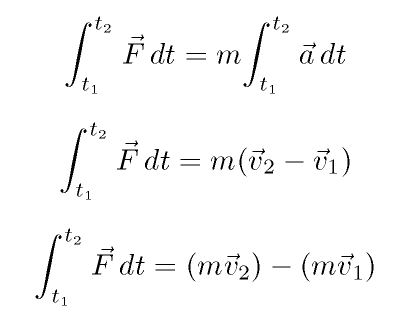J = Δp
| J = | ⌠ ⌡ | F dt |

EXPT 1: Observing Collision Forces That Change with Time
This experiment will be an elastic collision. For this experiment we will have our cart collide into a springy bit that extends out from another cart. Attached to the colliding cart is a force sensor that we will line up with the springy bit upon collision. At the other end of the track will be a motion sensor.
This apparatus will test the theorem in which J = Δp.
We create a force vs. time graph and velocity vs. time graph. To measure impulse acting on the cart by taking the area under the force vs. time graph for collision. We measure the change in momentum of the cart by knowing its mass and measuring its velocity before and after the collision using the motion detector.
We then did the calculations to verify the impulse-momentum theorem.
The calculated change in momentum of the cart and the measured impulse applied to it by the spring during the nearly elastic collision did not equal one another. We had an error of 4.9%.
EXPT 2: A Larger Momentum Change
This experiment is exactly the same as the first one, except this time we're adding more mass to the cart. We added 400 g to the cart and will test if the impulse and change in momentum will equal one another.
The calculated change in momentum of the cart and the measured impulse applied to it by the spring during the nearly elastic collision did not equal one another. We had an error of 5.4%.
EXPT 3: Impulse-Momentum Theorem in an Inelastic Collision
This experiment will be an inelastic collision. Replacing the springy part with a wooden pole clamped to the table with a piece of clay on it. On the cart we attached to the force sensor a plunger with a nail sticking out so that upon impact the nail on the cart would inelastically collide with the clay part on the wooden pole.
We are still testing the theorem in which J = Δp.
This time our final velocity will be zero.
Again we did the calculations to verify the impulse-momentum theorem.
The calculated change in momentum of the cart and the measured impulse applied to it by the spring during the nearly elastic collision did not equal one another. We had an error of 3%.
For all experiment momentum is generally suppose to be conserved but the numbers say otherwise. This is due to the equipment and the method of the experiment is to enact at best a frictionless surface. So having an error in low proximity with one another is okay. In a perfect world the measured impulse and the calculated change in momentum is suppose to be the same. Showing us that impulse-momentum is conserved.










No comments:
Post a Comment